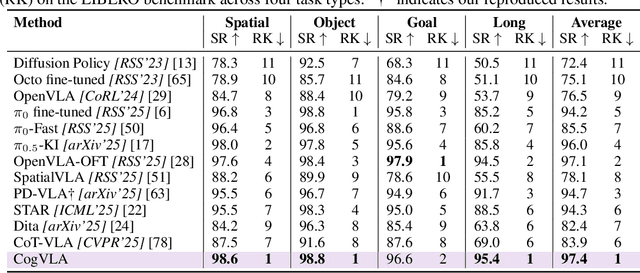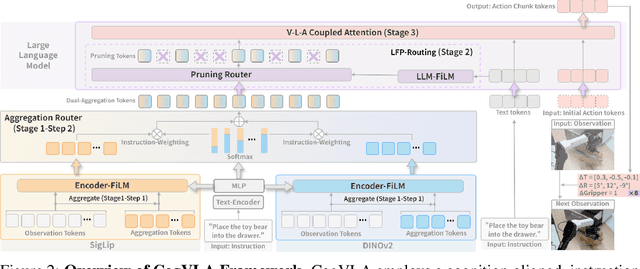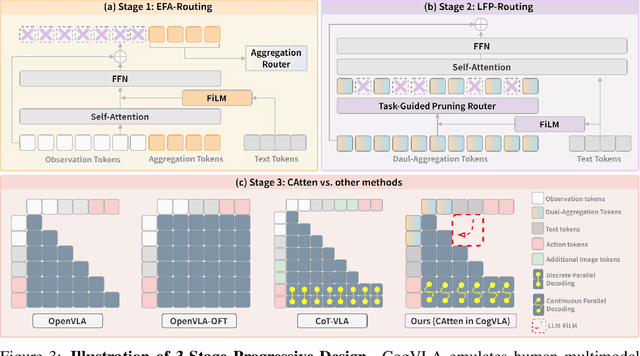Wei Li
College of Computer Science and Engineering, Northeastern University, Shenyang, China
Mitigating Overthinking through Reasoning Shaping
Oct 10, 2025Abstract:Large reasoning models (LRMs) boosted by Reinforcement Learning from Verifier Reward (RLVR) have shown great power in problem solving, yet they often cause overthinking: excessive, meandering reasoning that inflates computational cost. Prior designs of penalization in RLVR manage to reduce token consumption while often harming model performance, which arises from the oversimplicity of token-level supervision. In this paper, we argue that the granularity of supervision plays a crucial role in balancing efficiency and accuracy, and propose Group Relative Segment Penalization (GRSP), a step-level method to regularize reasoning. Since preliminary analyses show that reasoning segments are strongly correlated with token consumption and model performance, we design a length-aware weighting mechanism across segment clusters. Extensive experiments demonstrate that GRSP achieves superior token efficiency without heavily compromising accuracy, especially the advantages with harder problems. Moreover, GRSP stabilizes RL training and scales effectively across model sizes.
A Spatial-Spectral-Frequency Interactive Network for Multimodal Remote Sensing Classification
Oct 06, 2025Abstract:Deep learning-based methods have achieved significant success in remote sensing Earth observation data analysis. Numerous feature fusion techniques address multimodal remote sensing image classification by integrating global and local features. However, these techniques often struggle to extract structural and detail features from heterogeneous and redundant multimodal images. With the goal of introducing frequency domain learning to model key and sparse detail features, this paper introduces the spatial-spectral-frequency interaction network (S$^2$Fin), which integrates pairwise fusion modules across the spatial, spectral, and frequency domains. Specifically, we propose a high-frequency sparse enhancement transformer that employs sparse spatial-spectral attention to optimize the parameters of the high-frequency filter. Subsequently, a two-level spatial-frequency fusion strategy is introduced, comprising an adaptive frequency channel module that fuses low-frequency structures with enhanced high-frequency details, and a high-frequency resonance mask that emphasizes sharp edges via phase similarity. In addition, a spatial-spectral attention fusion module further enhances feature extraction at intermediate layers of the network. Experiments on four benchmark multimodal datasets with limited labeled data demonstrate that S$^2$Fin performs superior classification, outperforming state-of-the-art methods. The code is available at https://github.com/HaoLiu-XDU/SSFin.
MinerU2.5: A Decoupled Vision-Language Model for Efficient High-Resolution Document Parsing
Sep 26, 2025Abstract:We introduce MinerU2.5, a 1.2B-parameter document parsing vision-language model that achieves state-of-the-art recognition accuracy while maintaining exceptional computational efficiency. Our approach employs a coarse-to-fine, two-stage parsing strategy that decouples global layout analysis from local content recognition. In the first stage, the model performs efficient layout analysis on downsampled images to identify structural elements, circumventing the computational overhead of processing high-resolution inputs. In the second stage, guided by the global layout, it performs targeted content recognition on native-resolution crops extracted from the original image, preserving fine-grained details in dense text, complex formulas, and tables. To support this strategy, we developed a comprehensive data engine that generates diverse, large-scale training corpora for both pretraining and fine-tuning. Ultimately, MinerU2.5 demonstrates strong document parsing ability, achieving state-of-the-art performance on multiple benchmarks, surpassing both general-purpose and domain-specific models across various recognition tasks, while maintaining significantly lower computational overhead.
TISDiSS: A Training-Time and Inference-Time Scalable Framework for Discriminative Source Separation
Sep 19, 2025Abstract:Source separation is a fundamental task in speech, music, and audio processing, and it also provides cleaner and larger data for training generative models. However, improving separation performance in practice often depends on increasingly large networks, inflating training and deployment costs. Motivated by recent advances in inference-time scaling for generative modeling, we propose Training-Time and Inference-Time Scalable Discriminative Source Separation (TISDiSS), a unified framework that integrates early-split multi-loss supervision, shared-parameter design, and dynamic inference repetitions. TISDiSS enables flexible speed-performance trade-offs by adjusting inference depth without retraining additional models. We further provide systematic analyses of architectural and training choices and show that training with more inference repetitions improves shallow-inference performance, benefiting low-latency applications. Experiments on standard speech separation benchmarks demonstrate state-of-the-art performance with a reduced parameter count, establishing TISDiSS as a scalable and practical framework for adaptive source separation.
Cross-Modal Deep Metric Learning for Time Series Anomaly Detection
Sep 16, 2025Abstract:To effectively address the issues of low sensitivity and high time consumption in time series anomaly detection, we propose an anomaly detection method based on cross-modal deep metric learning. A cross-modal deep metric learning feature clustering model is constructed, composed of an input layer, a triplet selection layer, and a loss function computation layer. The squared Euclidean distances between cluster centers are calculated, and a stochastic gradient descent strategy is employed to optimize the model and classify different time series features. The inner product of principal component direction vectors is used as a metric for anomaly measurement. The von Mises-Fisher (vMF) distribution is applied to describe the directional characteristics of time series data, and historical data is used to train and obtain evaluation parameters. By comparing the principal component direction vector of actual time series data with the threshold, anomaly detection is performed. Experimental results demonstrate that the proposed method accurately classifies time series data with different attributes, exhibits high sensitivity to anomalies, and achieves high detection accuracy, fast detection speed, and strong robustness.
Enhancing Physical Consistency in Lightweight World Models
Sep 15, 2025Abstract:A major challenge in deploying world models is the trade-off between size and performance. Large world models can capture rich physical dynamics but require massive computing resources, making them impractical for edge devices. Small world models are easier to deploy but often struggle to learn accurate physics, leading to poor predictions. We propose the Physics-Informed BEV World Model (PIWM), a compact model designed to efficiently capture physical interactions in bird's-eye-view (BEV) representations. PIWM uses Soft Mask during training to improve dynamic object modeling and future prediction. We also introduce a simple yet effective technique, Warm Start, for inference to enhance prediction quality with a zero-shot model. Experiments show that at the same parameter scale (400M), PIWM surpasses the baseline by 60.6% in weighted overall score. Moreover, even when compared with the largest baseline model (400M), the smallest PIWM (130M Soft Mask) achieves a 7.4% higher weighted overall score with a 28% faster inference speed.
Mini-o3: Scaling Up Reasoning Patterns and Interaction Turns for Visual Search
Sep 09, 2025Abstract:Recent advances in large multimodal models have leveraged image-based tools with reinforcement learning to tackle visual problems. However, existing open-source approaches often exhibit monotonous reasoning patterns and allow only a limited number of interaction turns, making them inadequate for difficult tasks that require trial-and-error exploration. In this work, we address this limitation by scaling up tool-based interactions and introduce Mini-o3, a system that executes deep, multi-turn reasoning -- spanning tens of steps -- and achieves state-of-the-art performance on challenging visual search tasks. Our recipe for reproducing OpenAI o3-style behaviors comprises three key components. First, we construct the Visual Probe Dataset, a collection of thousands of challenging visual search problems designed for exploratory reasoning. Second, we develop an iterative data collection pipeline to obtain cold-start trajectories that exhibit diverse reasoning patterns, including depth-first search, trial-and-error, and goal maintenance. Third, we propose an over-turn masking strategy that prevents penalization of over-turn responses (those that hit the maximum number of turns) during reinforcement learning, thereby balancing training-time efficiency with test-time scalability. Despite training with an upper bound of only six interaction turns, our model generates trajectories that naturally scale to tens of turns at inference time, with accuracy improving as the number of turns increases. Extensive experiments demonstrate that Mini-o3 produces rich reasoning patterns and deep thinking paths, effectively solving challenging visual search problems.
Multi-modal Uncertainty Robust Tree Cover Segmentation For High-Resolution Remote Sensing Images
Sep 05, 2025Abstract:Recent advances in semantic segmentation of multi-modal remote sensing images have significantly improved the accuracy of tree cover mapping, supporting applications in urban planning, forest monitoring, and ecological assessment. Integrating data from multiple modalities-such as optical imagery, light detection and ranging (LiDAR), and synthetic aperture radar (SAR)-has shown superior performance over single-modality methods. However, these data are often acquired days or even months apart, during which various changes may occur, such as vegetation disturbances (e.g., logging, and wildfires) and variations in imaging quality. Such temporal misalignments introduce cross-modal uncertainty, especially in high-resolution imagery, which can severely degrade segmentation accuracy. To address this challenge, we propose MURTreeFormer, a novel multi-modal segmentation framework that mitigates and leverages aleatoric uncertainty for robust tree cover mapping. MURTreeFormer treats one modality as primary and others as auxiliary, explicitly modeling patch-level uncertainty in the auxiliary modalities via a probabilistic latent representation. Uncertain patches are identified and reconstructed from the primary modality's distribution through a VAE-based resampling mechanism, producing enhanced auxiliary features for fusion. In the decoder, a gradient magnitude attention (GMA) module and a lightweight refinement head (RH) are further integrated to guide attention toward tree-like structures and to preserve fine-grained spatial details. Extensive experiments on multi-modal datasets from Shanghai and Zurich demonstrate that MURTreeFormer significantly improves segmentation performance and effectively reduces the impact of temporally induced aleatoric uncertainty.
CogVLA: Cognition-Aligned Vision-Language-Action Model via Instruction-Driven Routing & Sparsification
Aug 28, 2025



Abstract:Recent Vision-Language-Action (VLA) models built on pre-trained Vision-Language Models (VLMs) require extensive post-training, resulting in high computational overhead that limits scalability and deployment.We propose CogVLA, a Cognition-Aligned Vision-Language-Action framework that leverages instruction-driven routing and sparsification to improve both efficiency and performance. CogVLA draws inspiration from human multimodal coordination and introduces a 3-stage progressive architecture. 1) Encoder-FiLM based Aggregation Routing (EFA-Routing) injects instruction information into the vision encoder to selectively aggregate and compress dual-stream visual tokens, forming a instruction-aware latent representation. 2) Building upon this compact visual encoding, LLM-FiLM based Pruning Routing (LFP-Routing) introduces action intent into the language model by pruning instruction-irrelevant visually grounded tokens, thereby achieving token-level sparsity. 3) To ensure that compressed perception inputs can still support accurate and coherent action generation, we introduce V-L-A Coupled Attention (CAtten), which combines causal vision-language attention with bidirectional action parallel decoding. Extensive experiments on the LIBERO benchmark and real-world robotic tasks demonstrate that CogVLA achieves state-of-the-art performance with success rates of 97.4% and 70.0%, respectively, while reducing training costs by 2.5-fold and decreasing inference latency by 2.8-fold compared to OpenVLA. CogVLA is open-sourced and publicly available at https://github.com/JiuTian-VL/CogVLA.
A Survey of Scientific Large Language Models: From Data Foundations to Agent Frontiers
Aug 28, 2025



Abstract:Scientific Large Language Models (Sci-LLMs) are transforming how knowledge is represented, integrated, and applied in scientific research, yet their progress is shaped by the complex nature of scientific data. This survey presents a comprehensive, data-centric synthesis that reframes the development of Sci-LLMs as a co-evolution between models and their underlying data substrate. We formulate a unified taxonomy of scientific data and a hierarchical model of scientific knowledge, emphasizing the multimodal, cross-scale, and domain-specific challenges that differentiate scientific corpora from general natural language processing datasets. We systematically review recent Sci-LLMs, from general-purpose foundations to specialized models across diverse scientific disciplines, alongside an extensive analysis of over 270 pre-/post-training datasets, showing why Sci-LLMs pose distinct demands -- heterogeneous, multi-scale, uncertainty-laden corpora that require representations preserving domain invariance and enabling cross-modal reasoning. On evaluation, we examine over 190 benchmark datasets and trace a shift from static exams toward process- and discovery-oriented assessments with advanced evaluation protocols. These data-centric analyses highlight persistent issues in scientific data development and discuss emerging solutions involving semi-automated annotation pipelines and expert validation. Finally, we outline a paradigm shift toward closed-loop systems where autonomous agents based on Sci-LLMs actively experiment, validate, and contribute to a living, evolving knowledge base. Collectively, this work provides a roadmap for building trustworthy, continually evolving artificial intelligence (AI) systems that function as a true partner in accelerating scientific discovery.
 Add to Chrome
Add to Chrome Add to Firefox
Add to Firefox Add to Edge
Add to Edge